Business Analytics is not just a trending but also a very valuable career option in the current times. However, many still do not know what exactly Business Analytics is and how it works. There are a lot of other terms like Business Intelligence, Data Analytics, and Data Science that are often confused with Business Analytics, but they are all not the same.
This blog is a complete guide to what is Business Analytics, the types, how it works, what tools and skills are in demand, what are the key differences between business analytics and other related terms, what is the career scope, the type of jobs, salary packages, the trending courses, colleges, and so much more!
What is Business Analytics? How Does it Work?
Business Analytics, in simple words, is a process, a technique whose goal is to turn raw data into meaningful business insights to help the business grow and improve. However, it is not as simple as it seems to be.
This means that the business analysts have to understand the data and the business problem and then accordingly filter out only the useful data from the stack of the raw data provided to them. This looks quite a simple and easy process when we read this, however, it is not the case.
Many perceive Analytics to be just about beautiful charts, graphs, and dashboards. These visual aspects are a part of it too but Analytics is still a lot more than that. Also Read | Top Online Data Science Course
In reality, business analysts get a lot of suspect data which requires plenty of cleaning and scrubbing before it can even prove itself to be useful. And even after all the analysis is done, not all of the output is helpful. Some of it is just noise as analysts call it. Filtering out useful data is a real challenge in itself.
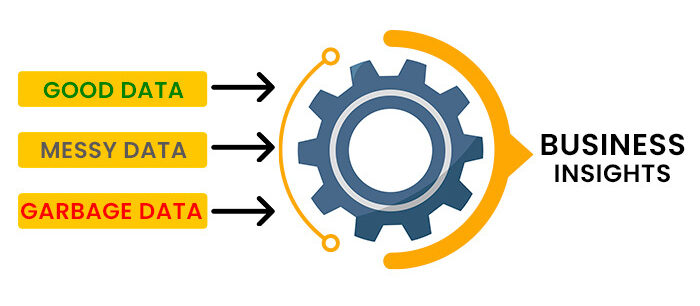
What Are the Examples of Business Analytics?
Let us understand Business Analytics with the help of a few examples
- For instance, if you work at a Credit Card company, then as an analyst, you could analyze data about your customers to determine who might subscribe to a credit card offer. This will allow you to spend more time and energy on targeting only these specific customers.
- You could work as a business analyst at a Regional Bank to review data about the loans to predict which customers are most likely to default.
- You could work as an analyst for a Tech company to review data about the employees of the company to analyze and understand why they leave and then take action accordingly to minimize turnover as it can get really expensive.
What Are The Types of Business Analytics?
There are 3 types of Business Analytics used by Analysts to work on data and help their businesses grow.
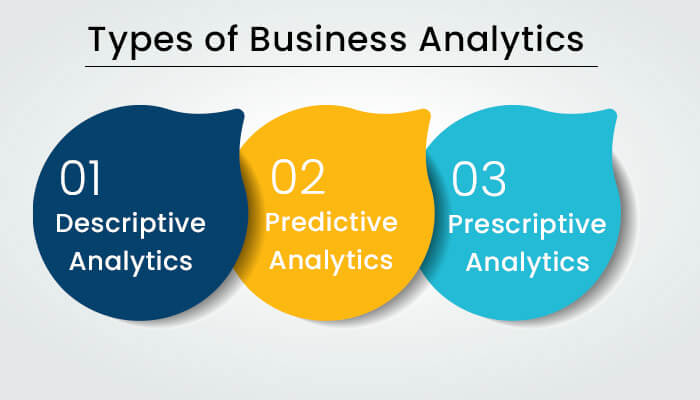
1. Descriptive Analytics
Descriptive Analytics deals with what happened in the past. Analysts review past data to analyze and understand past trends and make use of them in solving the present business problem.
When you do Descriptive Analytics, the type of questions that you ask are:
- What were our sales?
- What was our market share?
- What product was most popular?
2. Predictive Analytics
Predictive Analytics deals with what might happen in the future. Based on the data you receive, you make predictions about customer behavior after carefully analyzing and understanding the data. Predictive Analytics is closely related to the third type of Analytics which is Prescriptive Analytics.
3. Prescriptive Analytics
Prescriptive Analytics works with predictive analytics. Based on the predictions from predictive analytics of the future, what should be done, is what prescriptive analytics deals with.
When you do predictive and prescriptive analytics, the type of questions that you ask are:
- What are the expected sales?
- What is the expected market share?
- What product should we market to our customers?
How Does Business Analytics Work- The Life Cycle?
A Business Analytics Life Cycle is like a scientific method for analytics, a tried and true way of doing things. The most common Business Analytics Life Cycle is called the Crisp-DM. It is the cross-industry standard process for data mining which consists of only 5 stages.
You start with a Business Understanding followed by Data Understanding then Data Preparation, then Modelling, and then finally Evaluation & Deployment of the model.
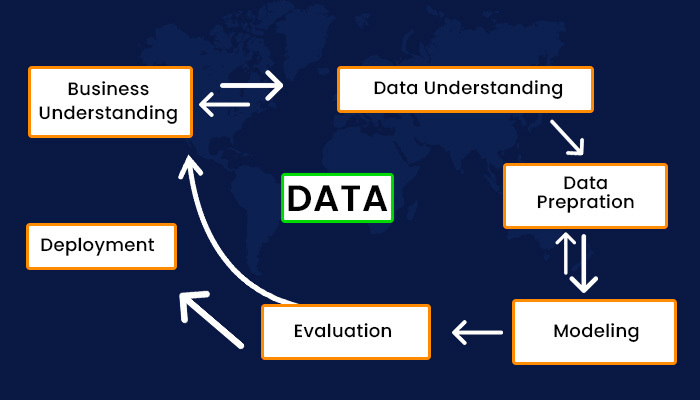
Why Is the Business Analytics Life Cycle Important?
Business Analytics is a step-by-step process and each stage has its importance. If you just rush into final analytics skipping the important steps, you might just crash. Like if you do not understand the business problem, you will not have a proper business goal to achieve.
Let us now discuss each of these 5 steps of the Business Analytics Lifecycle to know their role and importance
1. Business Understanding
The first and the most important stage is understanding what the business problem is. One should always start with the business problem as it helps to determine the business goal. Without having a concrete goal in mind, you might divert from the actual problem and not get the desired results.
Examples:
- Optimizing pricing to boost revenue.
- Segmenting customers to tailor product offers.
- Pinpoint bottlenecks and failure points in the supply chain.
2. Data Understanding
There are two important aspects of this stage. One is what data you have and the second is what data you need. A lot of what you do at this stage is looking at these two aspects and trying to cover the gaps between them.
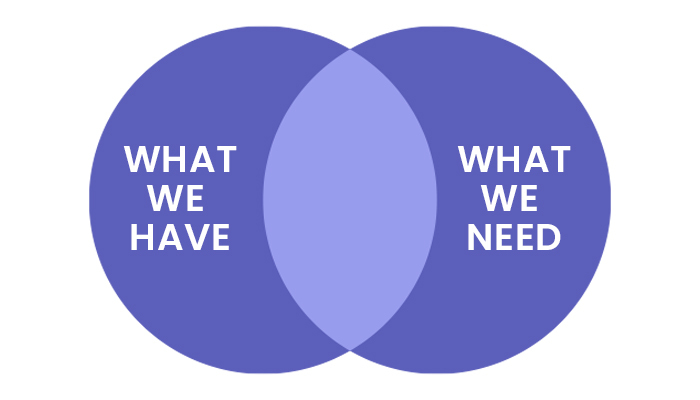
Once you get the data you need, you might ask questions like:
- What is the availability of the data?
- What is the quality of the data?
- What is the granularity (how deep or detailed does it go)?
- What is the frequency (how often does it get updated)?
While understanding the DATA, analysts often use a Sandbox which is like a safe space to explore their data so that they do not mess up with what is called the ‘Production’ where all the live data is. This is to be on the safer side to prevent things like accidentally deleting something while trying to understand the data.
3. Data Preparation
In this stage, the data is processed in order to filter out only the useful data after understanding the data in the previous stage. This is oftentimes the most time-consuming phase of the entire lifecycle. This is because it takes a lot of time and effort to clean and scrub the data to get it ready for further modeling and analysis.
4. Modelling
Before understanding the process of modeling, let us first know what a model is. In simple words, a model is something that mimics the real world or you could say that a model is our version of the real world. Just like there are miniature models of houses that mimic actual houses, in analytics, as we try to make predictions, we try to build a good and simple model to help us make our predictions.
Following are the few things that are needed to be done in this modeling phase.
- Exploratory Analysis of the data.
- Variable Selection to figure out what variables should be included in our model.
- Model Selection and then fine-tune it.
Some of the common tools used for modeling are the Python and R programming languages. We will discuss them along with other analytics tools later.
5. Evaluation & Deployment
This is the final stage of the Analytics Lifecycle. So, once the business question has been defined, the data has been understood and prepared, and the model has been built, it is time to evaluate and deploy the model.
This is the stage where you ask questions like:
- How effective is this model?
- Is it working well?
- Are the predictions fairly accurate?
- And if so, are we prepared to launch it?
This means that once the model is built, the job is still not done. You first evaluate the model, and ask the above questions, if everything is as desired then only you deploy the model. If not, then you go back to the first step repeat the cycle, and find out the loopholes before deployment.
Business Analytics & Related Terms
There are certain keywords that are often accompanied by Business Analytics like Business Intelligence, Decision Science, Data Mining, Decision Making, Data Science, and Data Analytics.
Although all these terms work towards more or less the same goal, there still are a few key differences between them. These key differences are described below for you to get a clear picture of what exactly are each of the terms, and how they differentiate from each other.
Business Analytics vs Business Intelligence
The terms business analytics and business intelligence are usually confused to be the same and are oftentimes used interchangeably. However, there is a difference between them. They are two different techniques that complement each other to perform a certain task.
The key difference is that Business Intelligence (BI) focuses on descriptive analysis and comes before the implementation of business analytics, while business analytics usually focuses on predictive analysis.
This means that before implementing Business Analytics for a particular business problem, BI is first used to analyze the business operations of the past to know what practices have taken place and which of them have room for improvement. Hence BI uses descriptive analyses.
On the other hand, when descriptive analytics is done, business analytics is then used to generate solutions and actionable insights to help decision-makers. Instead of looking at the past, business analytics looks at the future by predicting trends.
In short, BI collects data from past trends which serves as the groundwork for business analytics to predict future trends. BI helps business analytics to only choose specific areas to analyze that are relevant to the business problem.
Business Analytics vs Data Analytics
Data analytics is nothing but analyzing huge sets of data to draw useful conclusions. Data analytics does not have any specific goal. On the other hand, business analytics is analyzing data sets to draw conclusions that can help solve business issues.
Data analytics is a broader practice and business analytics is a part of data analytics. In short, data analytics when done to solve a business issue becomes business analytics.
Business Analytics vs Data Science
Data science can be considered an advanced version of business analytics as it involves the use of advanced statistical methods. The key difference between the two however is that while business analytics finds solutions to specific business problems or questions, data science on the other hand focuses more on looking for answers to open-ended questions.
Business analytics finds solutions to problems that can be dealt with with the help of just descriptive, predictive, and prescriptive analysis. On the other hand, data science aims to solve complex problems using advanced technology like artificial intelligence, machine learning, deep learning, and other custom coding.
Also, Read | Data Science Vs Artificial Intelligence Vs Machine Learning
Best Business Analytics Tools Trending In 2025
Business analytics works on data and the data generated in today’s times is humongous. There are huge sets of data that can not be dealt with manually. Also, the data that is generated now is unstructured and in various multimedia forms. Hence, there are certain tools that have been developed to help business analysts do the job efficiently.
Some of the basic business analytics tools are:
- Microsoft Excel: Allows you to explore/analyze smaller data sets.
- Tableau Desktop / Microsoft Power BI: Allows you to visualize your data with dashboards.
- Python / R: Allows you to build statistical models that can make predictions about your data.
- SQL: Allows you to communicate and interact with databases.
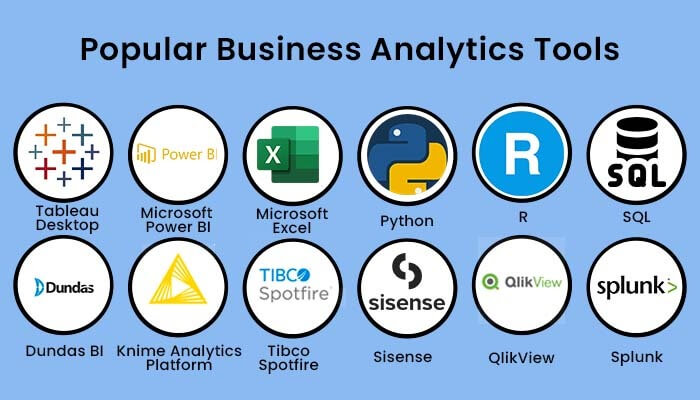
There are many other modern tools and techniques as well that have been designed over time with improved facilities. Some of the most popular ones are as follows:
- Dundas BI
- Knime Analytics Platform
- Tibco Spotfire
- Sisense
- QlikView
- Splunk
What Are the Scope Of Business Analytics?
Business Analytics is not restricted to just one subject or field. In business analytics, you mostly ride between a few different disciplines. Business is the one field that you absolutely must be familiar with, however, you might also need skills in technology and Mathematics.
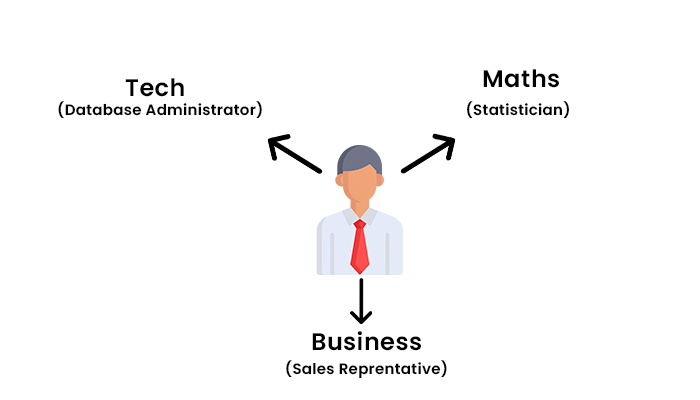
A career in the field of Business Analytics is surely a good option. There is a lot of scope in the field now because businesses have become very particular about the new technologies emerging that help businesses grow.
Almost each and every business is slowly moving towards the internet. Online businesses are flourishing but there are reasons for it and business analytics is one of them. Business owners are now more aware of the role of business analysts and how important they are for their firms. There have been multiple surveys that predict the growth in demand for market research analysts and operations research analysts in the next 10 years.
What Are the Job Roles and Salary In Business Analytics?
In Business Analytics, there could be two different categories of jobs. The job could be a business role that is supplemented with Analytics, like jobs such as Finance professionals. Or, the role could be just analytics and some of the common job roles for this category are Business Analyst, Business Intelligence Analyst, Analytics Manager, Data Analyst, Data Scientist (requires more technical background), and more.
Following are the top job roles and their respective salaries
| Job Role | Average Base Salary |
| Business Analyst | ₹6,16,471/- |
| Business Intelligence Analyst | ₹6,04,658/- |
| Analytics Manager | ₹17,81,826/- |
| Data Analyst | ₹4,69,593/- |
| Business Systems Analyst | ₹7,77,266/- |
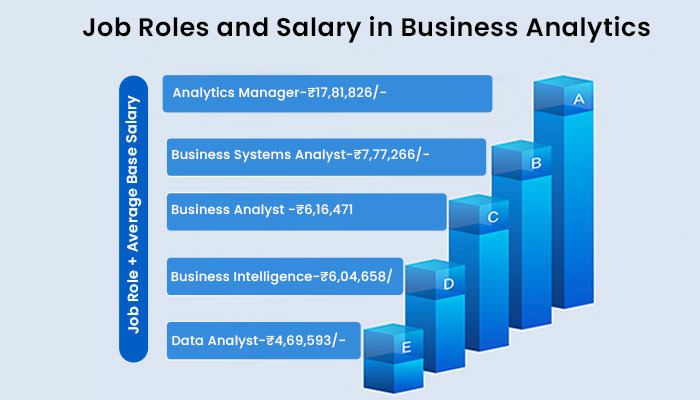
Business Analytics Courses Trending In 2025
Business Analytics is a broad field that requires you to have knowledge of different subjects apart from Business like Mathematics, Statistics, and other technology-related subjects like Computer Science. This makes Business Analytics a complex and advanced subject requiring deep knowledge.
However, Business Analytics is just a specialization and there are not many degree courses that are completely dedicated to it. But you do not need to worry, because many online degree courses specialize in Business Analytics. This means that these courses specifically focus on the field of Business Analytics and the curriculum is designed in a way that facilitates job-oriented knowledge and skills.
You can pursue a career in Business Analytics by opting for one of the following online courses.
- Online BBA in Business Analytics
- Online MBA in Business Analytics
- Online M.Sc in Business Analytics
- Online Executive MBA in Business Analytics
Best Online Colleges/Universities for Business Analytics Courses In 2025
If you are thinking of a career in Business Analytics and you have decided on one of the above courses to pursue, then given below are some of the best colleges that offer these online degree courses in Business Analytics.
| Online College Name | Courses In Business Analytics | Average Academic Fee |
| Amity University Online | MBA Online | 2,25,000 |
| Jain Online University | BBA Online | 2,40,000 |
| Online MBA | 2,00,000 | |
| DY Patil Vidyapeeth | MBA ODL | 1,30,000 |
| University of Petroleum and Energy Studies (UPES) | MBA ODL | 1,35,000 |
| BITS Pilani (WILP) | MBA WILP Mode | 2,31,000 |
| M.Sc WILP Mode | 6,10,000 | |
| Manipal Online University | M.Sc Online | 2,60,000 |
| BBA Online | 1,70,000 | |
| NMIMS Global | Online Executive MBA | 4,00,000 |
| IIM Ahmedabad | Executive MBA | 27,00,000 |
| Indian School of Business | Executive MBA | 39,00,000 |







